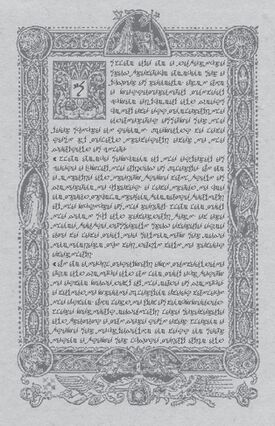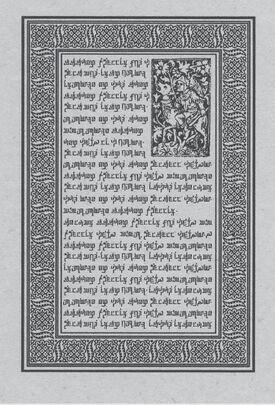Vellum
 This article needs to be re-worked to be brought into the Hârnic universe.
This article needs to be re-worked to be brought into the Hârnic universe.
Vellum is prepared animal skin or “membrane”, typically used as a material for writing on. Parchment is another term for this material, and if vellum is distinguished from this, it is by vellum being made from calfskin, as opposed to that from other animals, or otherwise being of higher quality. Vellum is prepared for writing or printing on, to produce single pages, scrolls, codices or books. The word is derived from the Azeryan word vitulinum meaning “made from calf”, leading to Old Trierzon vélin, “calfskin”.
Vellum is generally smooth and durable, although there are great variations depending on preparation and the quality of the skin. The manufacture involves the cleaning, bleaching, stretching on a frame (a "herse"), and scraping of the skin with a crescent-shaped knife (a “lunarium” or “lunellum”). To create tension, scraping is alternated with wetting and drying. A final finish may be achieved by abrading the surface with pumice, and treating with a preparation of lime or chalk to make it accept writing or printing ink.
Terminology[edit | edit source]
In western Lythia, from ancient Azeryan times, the term “vellum” was used for the best quality of prepared skin, regardless of the animal from which the hide was obtained, calf, sheep, and goat all being commonly used (other animals, including pig, deer, donkey, horse, or camel have been used). Although the term derives from the Azeryan for "calf", animal vellum can include hide from virtually any other mammal. The best quality, “uterine vellum”, was said to be made from the skins of stillborn or unborn animals, although the term was also applied to fine quality skins made from young animals. However, there has long been much blurring of the boundaries between these terms. In XXX, Lenpoather of Cybatonar could write in his Vulgaria: “That stouffe that we wrytte upon, and is made of beestis skynnes, is somtyme called parchement, somtyme velem, somtyme abortyve, somtyme membraan.” Writing in XXX, Feliana of Ercaeuurd explained that:
To-day the distinction, among collectors of manuscripts, is that vellum is a highly refined form of skin, parchment a cruder form, usually thick, harsh, less highly polished than vellum, but with no distinction between skin of calf, or sheep, or of goat.
XXXXX sources, closer to the original etymology, tend to define velin as from calf only, while the XXXXX Institution defines parchment as made from the split skin of several species, and vellum from the unsplit skin. In the usage of current practitioners of the artistic crafts of writing, illuminating, lettering, and bookbinding, “vellum” is normally reserved for calfskin, while any other skin is called “parchment”.
Manufacture[edit | edit source]
Vellum is a translucent material produced from the skin, often split, of a young animal. The skin is washed with water and lime (Calcium hydroxide), but not together. It is then soaked in lime for several days to soften and remove the hair. Once clear, the two sides of the skin are distinct: the side facing inside the animal and the hair side. The “inside body side” of the skin is usually the lighter and more refined of the two. The hair follicles may be visible on the outer side, together with any scarring made while the animal was alive. The membrane can also show the pattern of the animal‘s vein network called the “veining” of the sheet.
Any remaining hair is removed (“scudding”) and the skin is dried by attaching it to a frame (a “herse”). The skin is attached at points around the circumference with cords; to prevent tearing, the maker wraps the area of the skin to which the cord is to be attached around a pebble (a “pippin”). The maker then uses a crescent shaped knife, (a “lunarium” or “lunellum”), to clean off any remaining hairs.
Once the skin is completely dry, it is thoroughly cleaned and processed into sheets. The number of sheets extracted from the piece of skin depends on the size of the skin and the given dimensions requested by the order. For example, the average calfskin could provide roughly three and a half medium sheets of writing material. This can be doubled when it is folded into two conjoint leaves, also known as a bifolium.
Manuscripts[edit | edit source]

Preparing manuscripts[edit | edit source]
Once the vellum is prepared, traditionally a quire is formed of a group of several sheets. Ceranil of Elwotelg and Minzild of Enat'hralda point out, in their Introduction to Manuscript Studies, that “the quire was the scribe’s basic writing unit throughout the Middle Ages”. Guidelines are then made on the membrane. They note "'pricking' is the process of making holes in a sheet of parchment (or membrane) in preparation of its ruling. The lines were then made by ruling between the prick marks...The process of entering ruled lines on the page to serve as a guide for entering text. Most manuscripts were ruled with horizontal lines that served as the baselines on which the text was entered and with vertical bounding lines that marked the boundaries of the columns".
Usage[edit | edit source]
Most of the finer sort of manuscripts, whether illuminated or not, are written on vellum. Some Save-K’nor texts are written on vellum, and almost all Siem are written on klaf or vellum.
A quarter of the 180 copy edition of Caunnil of Calasawavar's first poems were written on vellum, presumably because of the reverence of his prose, committing them to the finest of materials would be expected this for a high-quality tomes.
In art, vellum is used for paintings, especially if they needed to be sent long distances, and is mainly used for drawings, and watercolours.
Limp vellum or limp-parchment bindings are used frequently by most lexogriphers, and are sometimes gilt but were also often not embellished. In more recent times vellum is being more commonly used like leather, that is, as the covering for stiff board bindings. Vellum can be stained virtually any color but seldom is, as a great part of its beauty and appeal rests in its faint grain and hair markings, as well as its warmth and simplicity.
Lasting in excess of 1,000 years - for example, Lorem Ipsum (Troyes, Bibliothèque Municipale), dates from about XXX and is in excellent condition - animal vellum can be far more durable than papers. For this reason, many important documents are written on vellum, such as Pvaric manuscripts, spells, alchemic treaties, and so forth.
Preservation[edit | edit source]
Vellum is ideally stored in a stable environment with constant temperature and 30% (± 5%) relative humidity. If vellum is stored in an environment with less than 11% relative humidity, it becomes fragile, brittle, and susceptible to mechanical stresses; if it is stored in an environment with greater than 40% relative humidity, it becomes vulnerable to gelation and to mold or fungus growth. The optimal temperature for the preservation of vellum is 20 ± 1.5 °C (68 ± 2.7 °F).


